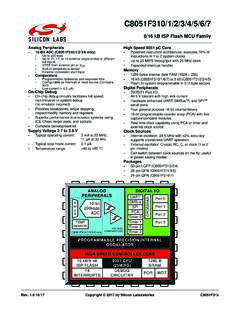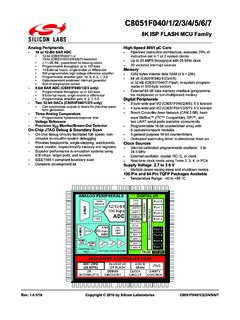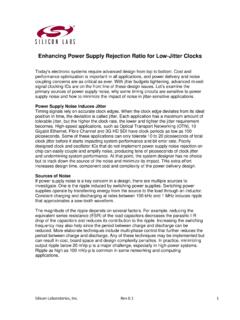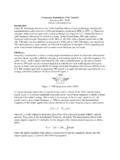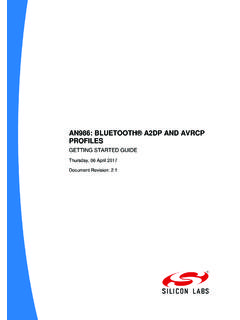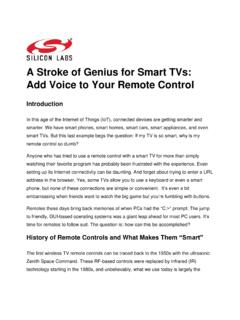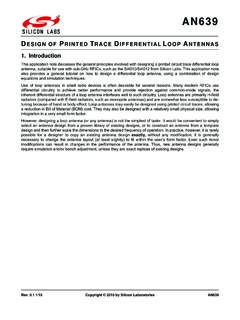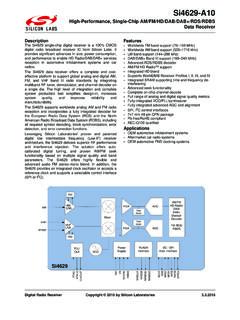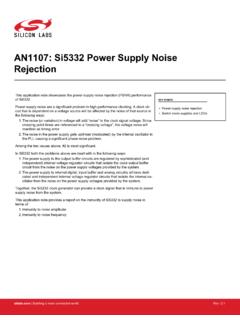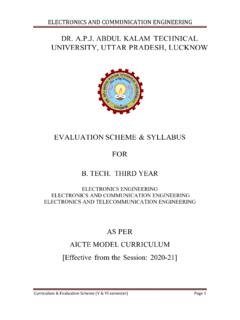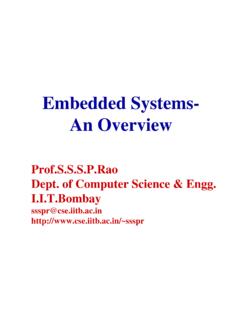Transcription of AN295: USB Audio Class Tutorial
1 Rev. 6/06 Copyright 2006 by Silicon LaboratoriesAN295AN295 USB Audio Class TUTORIAL1. IntroductionIsochronous data transfers can be used by universal serial bus (USB) devices designed to transfer data to or froma host at a constant rate. Systems streaming Audio employ isochronous transfers to transmit Audio signals in real-time. Silicon Laboratories microcontrollers robust USB peripheral supports isochronous transfers, and eachfamily s assortment of additional high quality peripherals make them excellent single-chip solutions for USB-basedembedded system document contains the following: A USB protocol overview concentrating on isochronous transfers A Firmware Template that provides a starting point for custom USB Audio Class device firmware An example system illustrating requirements and operation of USB Audio Class OverviewThe first section of this application note discusses the key points of the USB specification that must be followed byall USB devices, as well as isochronous transfer protocol requirements.
2 The second section introduces theFirmware Template for USB Audio Class devices. The last section discusses an example USB Audio Class example shows an Audio Class device that streams a sine wave to the USB, Isochronous Transfers, and the Audio ClassThe USB communications protocol outlines specifications for a reliable and fast system of data transfer between aperipheral and a host such as a PC. The protocol defines four different data transfer types (bulk, interrupt, control,and isochronous), each with unique characteristics and uses. USB device classes employ transfer types that suitthe needs of particular applications and systems. The USB Audio Class uses the isochronous transfer type tostream Audio across a USB USB Operational OverviewWhen a USB device connects to a USB port, the host controlling the port retrieves information about thecapabilities of a device through control transfers during a process called enumeration.
3 Devices format thisinformation into descriptors. USB Specification documents define the structure of devices send and receive data through endpoints. All USB devices must have one control endpoint throughwhich all enumeration data travels. Descriptors read during enumeration describe the device s other endpoints,their data flow direction, maximum packet size, transfer type, and other characteristics used after enumerationsuccessfully examining the device s descriptors, the host determines how to communicate with the device. If the host canallocate resources (data bandwidth, power) requested by the device, then enumeration completes successfullyand the host begins operations communication with the device. During operations communications, transfermethods such as those using isochronous endpoint transfers take Isochronous Transfer CharacteristicsThe host guarantees bandwidth to isochronous endpoints.
4 This bandwidth guarantee is a feature unique toisochronous endpoints. The amount of bandwidth allocated to a particular isochronous endpoint is determined byinformation requested by that endpoint s descriptor. Data transfers take place inside USB data frames. For FullSpeed USB devices such as the Silicon Laboratories C8051F32x, a data frame spans 1 millisecond. A device canbe configured to transmit as few as 1 byte per frame or as many as 1023 bytes per frame. The USB specification defines IN and OUT designations from the perspective of the host, meaning that INendpoints transmit data to the host and OUT endpoints receive data from the host. During every 1 millisecondinterval during communications operation, the host signals isochronous IN endpoints to transmit bytes to the host,and signals isochronous OUT endpoints to receive bytes from the host.
5 Unlike other transfer types, isochronous transfers have no hardware-controlled handshaking or error-checkingability, so errors may occur occasionally. Systems must be able to recover from occasional errors without the helpof The USB Audio ClassThe USB Specification documents group devices with similar capabilities into device classes. Device Classspecifications require that devices share many characteristics in common, while allowing for customization andinnovation. The Universal Serial Bus Device Class Definition for Audio Devices describes how Audio devicesmust perform, how Class -specific Descriptors must be defined, etc. Because host operating systems typicallycontain device drivers for defined USB classes, designers of these devices do not need spend resources ondeveloping their own device Creating an Audio Class Device With Silicon Laboratories MicrocontrollersThe creation of a USB Audio Class device requires two steps: Descriptors retrieved by the host must be configured to describe a device as following the specifications for Audio Class devices.
6 Device firmware must configure the microcontroller to enable USB isochronous transfers. The next section of this application note describes a Firmware Template that accomplishes the above two section following it provides an example of a USB Audio Class Firmware TemplateThe firmware template included with this application note allows users to create custom USB Audio Devices. Thetemplate contains all descriptors and routines needed to create a composite device with an Audio interface and anHID firmware template provides the following: Descriptors defining a USB device with two Audio Interfaces, one for full bandwidth and an alternate zero bandwidth interface Descriptors defining an HID interface with one IN endpoint, one OUT endpoint, and function stubs for Get Report and Set Report requests Low-level USB routines to handle all standard requests and interrupts for the Audio Class and the HID ClassThe following subsections show how the Firmware Template can be modified to suit a custom Audio streamingsystem.
7 DescriptorsOnly a few items in the descriptors contained in the Firmware Template will need to be changed to create a customsystem. Please read the section Tone Generator Reference Design for a more detailed explanation of file and how modifications to the descriptors affect the capabilities of the following is a checklist of descriptor items that may need to be modified in order to accurately describe thecharacteristics of a custom system: The VID and PID items located in the Device Descriptor (these can be changed in ) String index values (iProduct, iVendor, iInterface, etc.), depending on what strings the custom application defines wTerminalType, which specifies type of Audio Class device defined by the descriptor (Terminal Type values can be found in the document titled USB Device Class Definition for Terminal Types ) bNrChannels, which commonly describes a stereo (2-channel) terminal or a mono (1-channel) terminal wChannelConfig, which gives information on orientation of each channel (values can be found in the USB Device Class Definition for Audio Devices ) Master and channel controls, depending on what features the Audio Device supports (values can be found in the USB Device Class Definition for Audio Devices ) Audio Format Descriptor the template contains a descriptor structure for a Type I format Audio stream.
8 Using other types of streams (defined in the document titled USB Device Class Definition for Audio Data Formats ) may alter the size and structure of this descriptor) Contents of the default Type I Audio Descriptor these items describe the size of each sample, the sampling rate, etc. and must be changed to suit a custom system s specifications bEndpointAddress for the isochronous endpoint, depending on whether the custom application streams Audio into the host or out of the host HID Report Descriptor, depending on the system s report structure requirements (see AN249 for a more detailed discussion) The Report Descriptor s size, stored as HID_REPORT_SIZE in , to match the custom size of the Report DescriptorAN2954 Rev. Endpoint 3 HandlerThe descriptors configure Endpoint 3 to be the Audio Class s isochronous endpoint.
9 The USB Interrupt ServiceRoutine ISR will vector to the Endpoint 3 handler when it receives a token packet from the host requesting atransfer with that endpoint. The contents of this handler are highly system specific, but will most likely perform oneor more of the following tasks: For an IN stream from device to host, the handler places data on the Endpoint 3 FIFO. For an OUT stream from host to device, the handler processes FIFO data received from the host. The handler updates global variables used in other custom system-specific large amounts of data must be processed inside the handler, fast ISR execution speed becomes crucial tosystem stability. If the device has not finished servicing one ISR call when the host calls for the device to begin thenext ISR call, Audio packets might be lost.
10 In these cases, users should consider writing code for the USB ISR andoften-executed routines in embedded 8051 assembler language. At slower data rates, such as the rate used in theTone Generator example, the handler can be written in HID InterfaceFor communications across the HID Interface, users must make a number of modifications to Firmware Templatefiles. The HID Specification requires that all HID data be formatted into reports, which are data structures defined inone of the HID s descriptors. Reports can travel across the control endpoint or the interrupt endpoints, Endpoint 1and Endpoint 2. The Firmware Template defines Endpoint 1 as an IN endpoint and Endpoint 2 as an OUT Control Endpoint sends and receives HID reports through the standard requests Set Report and Get Report,respectively. Making the following modifications will enable HID data traffic: In , write endpoint handler routines that process HID IN or OUT endpoint traffic In , add calls to appropriate endpoint handlers in the USB Interrupt Service Routine.
